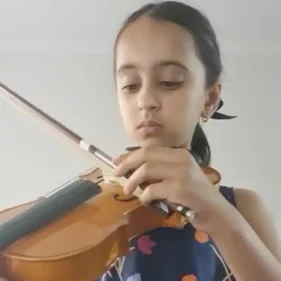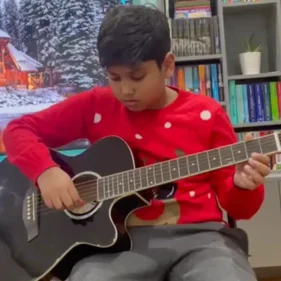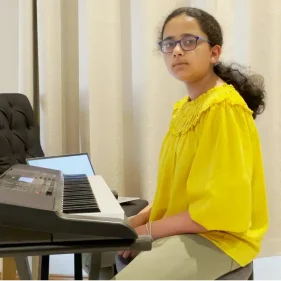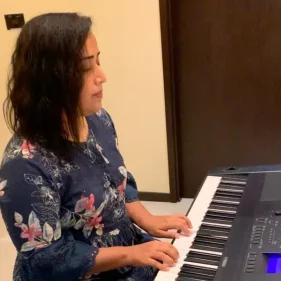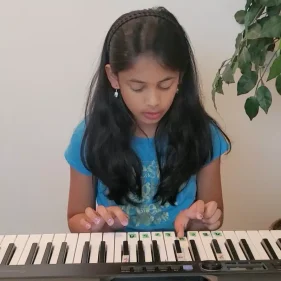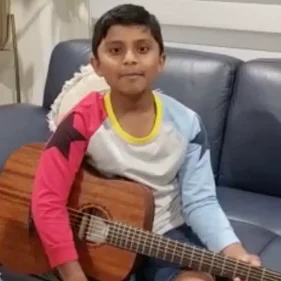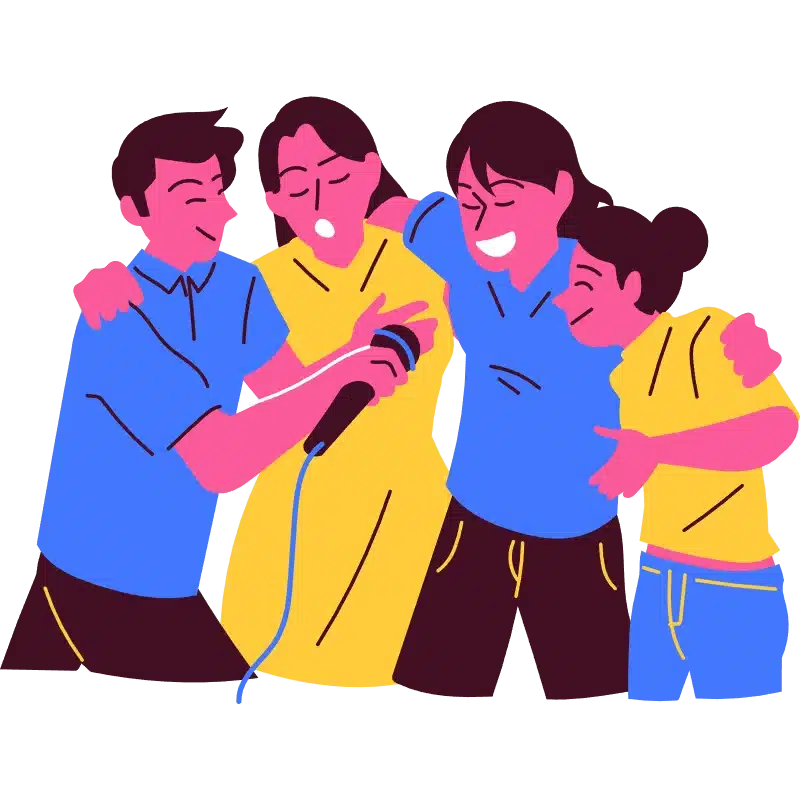Hindustani classical music originated in Northern India due to the Mughal empire’s influence of Carnatic music. One prominent manifestation of cultural identity is the musical experience that originated in a northen region. Indian Classical Music heavily contributes to the country’s culture and heritage. It is one of the oldest forms of music in the world and has its roots in diverse areas such as the ancient religious Vedic hymns, tribal chants, devotional temple music and folk music. Indian Music is melodic in nature, as opposed to Western music which is harmonic.
The most important point to note is that movements in Indian Classical Music are on a one-note-at-a-time basis. This progression of sound patterns along time is the most significant contributor to the tune of rhythm of the presentation and hence to the melody. Although Indian Music is divided into the two major classes of Hindustani (Northern Indian) and Karnatak or Carnatic (Southern Indian), the origins and fundamental concepts of both these types of music are the same. The form of presentation may however vary between the two systems, as well as from one gharana (family) to another in the former system.
Indian Classical Music is generally known as an oral tradition, where a Guru trains a student for many years. In this training, they develop a spiritual bond reflecting the musical experience and philosophical beliefs attached to the latter.
Fundamental Concepts of Hindustani Music
The fundamental concepts that have to be understood at the outset are those of swara (musical note), raga (a melodic concept, or scale of notes) and tala (beats of timing or rhythm). Some of the fundamental aspects of Hindustani music are listed as follows:
Patti
Unlike the case in Western music, the musical notes used in Indian music are not at standardized frequencies. One may choose any frequency of convenience as this reference, and this frequency would then act as the tonic or base of reference for the music to be presented. In Hindustani Music, Patti is that chosen frequency or the scale in which the performer sings or plays a song. This is like the Western concept of scales, i.e., C,D,E,F,G,A,B and their corresponding sharp scales.
Octaves or Saptak
Sapta is a Sanskrit word which means seven. So, a saptak in Hindustani Music means seven notes altogether. It is a Sanskrit word for an Octave. There are mainly three octaves used in Hindustani Classical Music known as Madhya Saptak (Middle or The Fourth Octave) , Mandra Saptak (Lower orThe Third Octave) and Taar Saptak (Upper or The Fifth Octave). In addition to these Octaves, Indian Classical Vocalists and Instrumentalists use Ati Mandra Saptak or The Second Octave while singing or playing instruments.
Shruti and Swaras
The sound which is capable of being used in music and which can be distinctly identified by the ear is called “Shruti” whereas the word swara (notes) is derived from the Sanskrit word “Swar”, which means sound. There are different forms of sound but the sound which is soothing to the ear and is musical and melodious is known as a swara or sur.
As a matter of fact both “Shruti” and “Swaras” are musical sounds capable of being heard. The distinction between the two is something like that which exists between the snake and its coil or between gold and the ornaments made out of it. All “Shrutis” are capable of being used as “Swaras” in various Ragas.
There are twenty two shrutis in Hindustani Classical Music out of which twelve major shrutis are known as “Swaras” the descriptive names of which are as follows:
Shadaj (Sa), Rishabh (Re), Gandhar (Ga), Madhyam (Ma), Pancham (Pa), Dhaivat (Dha), Nishad (Ni). The seven major notes are also known as Shuddha Swaras. Sa and Pa swaras are called pure swaras (Shuddha swaras) and are also known as Achal Swaras. Swaras other than the Achal swaras can be sung half note above or below their original position. They are known as Vikrit Swaras.
Re, Ga, Dha, Ni can be sung half a note below and are known as Komal Swaras. Ma is sung half a note above its original note and is known as Teevra Ma. Thus, in total there are twelve swaras – seven Shuddha and five Vikrit including four Komal Swaras and one Teevra. Thus, as a beginner the first step is to understand the Swara hierarchy. You can refer to the audio below to be more clear about the same:
Thaats and Ragas in Hindustani Music
In Hindustani (North Indian) Classical Music system, a thaat represents a Parent Scale that uses at least seven swaras/notes (out of the twelve swaras) to make a Raga. Out of the seven notes , Sa and Pa remains constant without variations but other notes: Re, Ga, Ma, Dha and Ni each have two variants (natural vs flat, or natural vs sharp), so there is a possibility of getting thirty two different thaats, but ten thaats are commonly used in Hindustani Music.
The modern thaat system was created by Vishnu Narayan Bhatkhande. He modeled his system after the Melakartha system of Carnatic Music classification.
A Thaat always has the following rules:
- A thaat must have seven tones out of the twelve tones out of the twelve tones (seven natural, four flat [(Re, Ga, Dha, Ni), one sharp (Ma)]
- The tones must be in ascending sequence: Sa Re Ga Ma Pa Dha Ni
- A thaat cannot contain both the natural and altered versions of a note
- A thaat, unlike a Raga, does not have separate ascending and descending lines
- A thaat has no emotional quality (which ragas, by definition, do have)
- Thaats are not sung but the ragas produced from the thaats are sung
Pandit Bhatkhande outlined ten Thaats, the specifications of which are listed below along with the popular Ragas in each thaat:
*NOTE – In notations listed below, Capital letters stands for Shuddha swaras, Small letters for Komal swaras and Teevra Madhyam.*
1. Kalyan Thaat – This Thaat has a group of evening ragas. As this Thaat is considered as blessing-seeking and soothing. It is sung at the beginning of a concert in the evening. Like Bhairav, this Thaat too is vast and so has many variations like Shuddha Kalyan, Shyam Kalyan, Yaman Kalyan, Anandi Kalyan, Khem Kalyan (Hamsdhwani + Yaman), Savani Kalyan, etc.
Notations: S R G m P D N (Teevra Madhyam)
Raagas: Kalyaan/ Shuddha Kalyan, Shyam Kalyan, Bhupali, Chaandni Kedaar, Chhayanat, Gaud Saarang, Hameer, Hindol, Kaamod, Kedaar, Nand, Yaman/ Aiman, Yaman Kalyaan
2. Bilawal Thaat – It’s the most fundamental of all the ten Thaats and is related to the morning.
Notations: S R G M P D N (All Shuddha Swaras)
Ragas: Bilaawal/ Alahiya Bilaawal, Bihaag, Nat Bihaag, Bihaagada, Deshkaar/ Desikaar, Durga, Hamsadhwani, Hemkalyaan, Kaushik Dhwani, Shankara
3. Khamaj Thaat – It is obtained by replacing the Shuddha Nishad of Bilawal by Komal Nishad. Its nature is romantic (Shringar Ras).
Notations: S R G M P D n (Only Nishaad is komal)
Ragas: Khamaaj, Desh, Gara, Gaud Malhaar, Gaawati, Gorakh Kalyaan, Jayjayvanti, Jhinjhoti, Jog, Kalaavati, Rageshri, Saraswati, Sorat, Tilak Kaamod, Tilang
4. Bhairav Thaat – Bhairav Thaat uses Komal Rishabh and Komal Dhaivat. It has manly and austere feelings. It is exceptionally huge and so constitutes a large number of note combinations like Ahir Bhairav, Alam Bhairav, Anand Bhairav, Bairagi Bhairav, Beehad Bhairav, Bhavmat Bhairav, Devata Bhairav, Gauri Bhairav, Nat Bhairav, Shivmat Bhairav, etc. It is typically sung in a devotional mood in the early morning.
Notations: S r G M P d N (Rishabh and Dhaivat are komal)
Ragas: Bhairav, Ahir-Bhairav, Nat-Bhairav, Gauri, Gunkali, Jogia, Kaalingadaa, Ramkali, Vibhaas
5. Poorvi Thaat – This is the mixture of komal Dhaivat to Marwa Thaat. It is intensely sober and is sung at sunset.
Notations: S r G m P d N (Rishabh , Dhaivat , both are komal; and Madhyam is Teevra)
Ragas: Poorvi, Basant, Lakshmi Kalyan, Lalit, Paraj, Puriya Dhanashri, Shree
6. Marwa Thaat – It’s a combination of komal Rishabh and Kalyan Thaat. This Thaat conveys the mood of the sunset and so has a feeling of nervousness.
Notations: S r G m P D N (Rishabh is komal, Madhyam is Teevra)
Ragas: Maarwa, Bhankar, Bhatiyaar, Lalit, Puriyaa, Puriyaa Kalyan, Sohini, Vibhaas
7. Kaafi Thaat – Kafi Thaat uses the Komal Gandhar and Komal Nishad. It’s a late evening raga and is associated with the spring.
Notations: S R g M P D n (Gandhar and Nishad both are komal)
Ragas: Kaafi, Abhogi, Bageshri, Bahaar, Barwaa, Bhimpalasi, Brindaavani Saarang, Chandrakauns, Dhaani, Jog, Megh, Ramdaasi Malhaar, Surdaasi Malhaar, Mian Malhar, Nayaki Kaanhadaa, Patdeep/ Patdeepki/ Pradipki, Piloo, Shahana, Shuddha Saarang
8. Asavari Thaat – Asavari Thaat is a blend of Komal Dhaivat and Kafi Thaat. It has the nature of renunciation and sacrifice as well as suffering. It is apt for late morning.
Notations: S R g M P d n (Gandhar, Dhaivat and Nishad all three are komal)
Ragas: Aasaavari, Adaanaa, Darbaari Kanhada, Kaunsi Kanhada, Desi, Dev Gandhar, Jaunpuri
9. Bhairavi Thaat – Bhairavi uses all the komal swaras, Rishabh, Gandhar, Dhaivat, Nishad. Bhairavi Raga is named after the cosmic feminine power( i.e. Shakti or Maa Durga). It conveys the feeling of devotion and compassion. It is actually sung in the early morning, yet customarily its singing ends the program.
Notations: S r g M P d n (Rishabh, Gandhar, Dhaivat, and Nishad all four are komal)
Ragas: Bhairavi, Bhupal Todi, Bilaskhaani Todi, Komal Rishabh Asavari, Malkauns
10. Todi Thaat – This is regarded as the King of all Thaats, as it symbolizes pleased worship with a placid, warm outlook and is sung in the late morning.
Notations: S r g m P d N (Rishabh, Gandhar and Dhaivat ,all three are komal; and Madhya Teevra)
Ragas: Todi, Gurjari Todi, Lilaavati, Madhuvanti, Multaani
Comparison of Hindustani Thaats with Carnatic Ragaas & Western Scales
| No | Thaat | Raga | Notes/Sargam | Western | Mela | Carnatic |
|---|---|---|---|---|---|---|
| 1 | Bilaval | Bilaval | S R G M P D N S’ | Ionian | 29th | Dheera Shankarabharanam |
| 2 | Kafi | Kafi | S R g M P D n S’ | Dorian | 22nd | Kharaharapriya |
| 3 | Bhairavi | Bhairavi | S r g M P d n S’ | Phrygian | 8th | Hanumatodi |
| 4 | Kalyan | Yaman | S R G m P D N S’ | Lydian | 65th | (Mecha)Kalyani |
| 5 | Khamaj | Khamaj | S R G M P D n S’ | Mixolydian | 28th | Harikambhoji |
| 6 | Asavari | Asavari | S R g M P d n S’ | Aeolian | 20th | Natabhairavi |
| 7 | Bhairav | Bhairav | S r G M P d N S’ | Double Harmonic | 15th | Mayamalavagowla |
| 8 | Marwa | Marwa | S r G m P D N S’ | — | 53rd | Gamanashrama |
| 9 | Poorvi | Poorvi | S r G m P d N S’ | — | 51st | Kamavardhini |
| 10 | Todi | Miyan ki Todi | S r g m P d N S’ | — | 45th | Shubhapantuvarali |
Tala & Laya
What is it that makes you nod or sway your head when you listen to a song? What makes you want to dance? It is the rhythm of the song. Melody and Rhythm go hand in hand in Indian Classical Music. It is important to sing in tune but it is equally important to understand the rhythmic aspect of it. In Indian Classical Music, rhythm is maintained through Taal and Laya.
Taal is a cycle of beats whereas Laya can be explained as the distance between two beats. Hence, the lesser the distance, the faster the tempo of the song and vice versa. There are three types of Laya – Vilambit Laya, Madhya Laya and Drut Laya. Chota Khayal is sung in Drut Laya, while Vilambit and Madhya Laya are used for singing Bada Khayal.
Beats are referred to as Matras in Indian Classical Music and one cycle of beats is called an Avartan. The first beat of each Avartan is known as ‘Sam’ which is represented by a plus (+) sign. An Avartan starts with ‘sam’ and ends with ‘sam’. When Taal is introduced to Music and dance, the beats are demonstrated with the help of claps (representing “Taali”), tapping fingers on the palm (to represent the subsequent beats/matra), and waving one hand in the air (representing “Khali”).
Here is an example of one Avartan in Teen Taal and how it starts with the first Taali and comes back to it on completion. Irrespective of whether the Taal is demonstrated on hand or any other percussion instrument, it will follow the same diktat. Teen Taal consists of 16 beats in a single Avartan:
The above example of Teen Taal is divided into 4 Vibhag. Each Vibhag is separated with the help of a vertical line or Purna Viram in Hindi.
There are nine major types of Taal in Hindustani Classical Music according to the count and structure of the beat. They are – Teentaal, Jhoomra, Tilwara, Dhamar, Ektaal, Chautaal, Jhaptaal, Keherwa, Roopak and Dadra.
Gayaki Style in Hindustani Classical
Khyal
Khyals are fixtures of Hindustani Classical pieces.There are two types of Khyals namely Bada Khyal and Chhota Khyal. Chhota Khyal is always sung in Drut Laya, while Vilambit and Madhya Laya is used for singing Bada Khyal. A Bada Khyal is often the first composition to begin after the Raga has been properly introduced. Khyal Gayan has shorter compositions with two parts only, Sthayi and Antara. In Khyal, the importance is on swaras (notes) rather than words. Normally, composition of Khyal is made up of fewer words, which means poetry is limited.
Dhrupad
Dhrupad is possibly the oldest surviving musical form of North India. A Dhrupad has at least four stanzas, called Sthayi, Antara, Sanchari and Abhoga. The Sthayi part is a melody that uses the middle octave’s first tetrachord and the lower octave notes. The Antara part uses the middle octave’s second tetrachord and the higher octave notes.
Tarana
A Tarana is a bandish in Classical Vocal Music framed in Raga and Taal, consisting of mere syllables produced on drums and other instruments. In a Tarana, the mnemonics are very similar to string instruments. Words like Dir Tom, Tarana, Derena, Dim Radare, Dani, etc. are employed and at the end syllables of the Tabla or Pakhawaj Paran are added as a climax. Tarana is composed of two parts – Sthayi and Antara. Some believe that Tarana of North India is an adaptation of Tillana of Carnatic music. Usually, Taranas are sung in a very fast tempo and Tarana singers are required to have good practice in tongue-twisting syllables.
Thumri and Ghazal
Nevertheless, Thumri, Ghazal and earlier counterparts, which we may retrospectively call ‘Light-classical’ have played an important role in Indian Music. The Ghazal is mainly a poetic form than a musical form, but it is more song-like than the thumri. Ghazal is described as the “pride of Urdu poetry” whereas Thumri on the other hand is romantic and devotional in nature and usually revolves around a girl’s love for Krishna. The language is a dialect of Hindi called Brij Bhasha. Apart from Thumri and Ghazal, some other types of popular Semi Classical Gayaki include Dadra, Bhajan, Chaiti, Kajri, Tappa, Natya Sangeet and Qawwali.
Alaap and Taan
An Alaap is the rendition of a Raag, emphasizing on the prominent features of that Raag. Alaaps are rendered in a slow tempo, and convey every essence of a Raag whereas a Taan is rendered by the musician using different combinations of the Swaras of a Raag in a fast tempo. Both Alaap and Taan are usually something the musician improvises with, and sung while singing khyals, dhrupads, etc and is a tribute to their talent, practice and their overall training.
While singing any style , Ras (emotion evoked by the Raga) plays a crucial role. The Ras is heightened by the time of the day and year that the Raag is rendered, as well as the emotion of the Raag. In Hindustani Music, there are fewer rules than Carnatic music. However, that being said, it is believed that some Ragas have an exemplary influence over natural conditions like the weather. Therefore, some Ragas like the ones under the Malhar category, are only sung during a specific season. The Malhar Ragas are sung mainly during the Monsoon season.
There are plenty of other basic concepts as well that are gradually introduced to students as they progress in their lessons.
Hindustani Music Instruments
Although Hindustani music clearly is focused on vocal performance, instrumental forms have existed since ancient times. In fact, in recent decades, especially outside South Asia, instrumental Hindustani music is more popular than vocal music, partly due to a somewhat different style and faster tempo, and partly because of a language barrier for the lyrics in vocal music.
Many musical instruments are associated with Hindustani classical music. The Veena, a string instrument, was traditionally regarded as the most important, but few play it today and it has largely been superseded by its cousins the sitar and the sarod, both of which owe their origin to Persian influences.
The Tanpura is also regarded as one of the most important instruments, due to its functioning as a fundamental layer that the rest of the instruments adhere to throughout a performance. Among bowed instruments, the Sarangi and Violin are popular.
The Bansuri, Shehnai and Harmonium are important wind instruments. In the percussion ensemble, the Tbla and the Pakhawajj are the most popular. Rarely used plucked or struck string instruments include the Surbahar, Sursringar, Santoor and various versions of the Slide Guitar. Various other instruments have also been used to varying degrees.
Concluding Thoughts
When one masters the art of expressing a sound beautifully, it becomes a swara. Beautifying it with a harmonious blend of Sur, Taal and Laya makes it music. Adding thoughts to it makes it a Khyal and improvising it with Alaap and Taan creates masterpieces.
Sur-Taal , tune and rhythm are a part of the universe. It is not something that was invented or created by humans, it is there all around us. It is for us to find within us. The rain drops in a rhythm and the way we breathe also follows a certain rhythm. All we have to do is to understand the principles of Taal and Laya that go into making melodies, only then we would be able to understand music in its totality.
In this way, Indian Classical Music is very closely connected to nature, taking inspiration from natural phenomena including seasons and times of the day to create “Ragas” or musical moods and many time cycles or “taals” that have been further codified. Compositions are fixed but most of the music is improvised within the structure of notes and mathematics. This gives the music a spontaneous freedom where each artist and every performance is ensured to be completely unique.




















